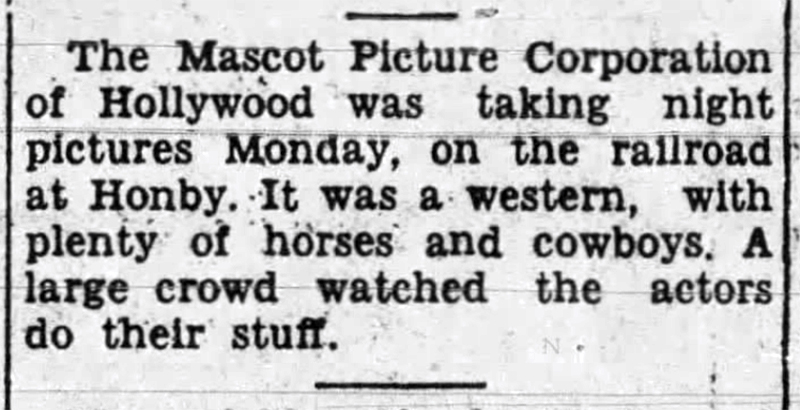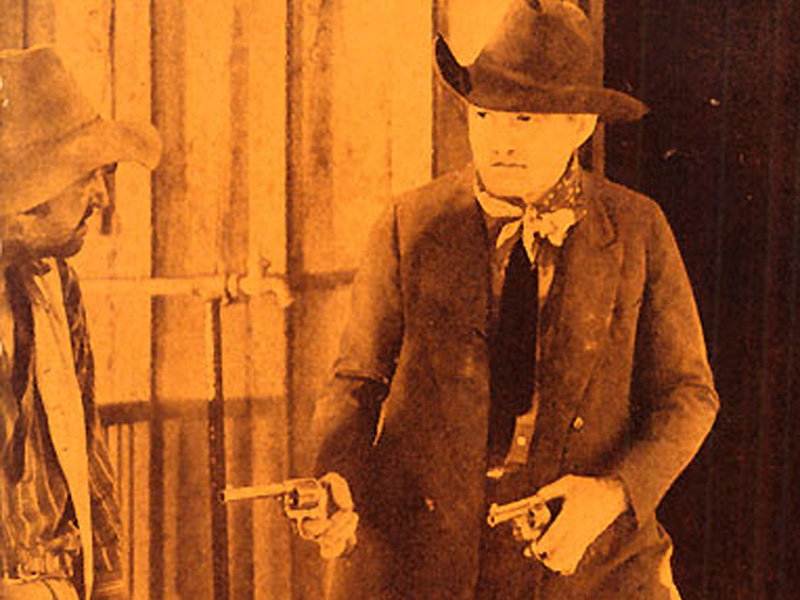|
|


Click image to enlarge
Saugus rancher and A-list actor Harry Carey Sr. cuts a fatherly figure in his third and final 12-chapter serial for Mascot Pictures, "The Devil Horse" (1932). (The others were "The Vanishing Legion" and "The Last of the Mohicans.") "The Devil Horse" is an expansion of the 1926 Hal Roach picture of the same name. Both pictures featured the stunt work of Yakima Canutt and a wild horse. They even used some of the same film footage, and the 1932 version matched locations in the Newhall area for continuity. Producer Nat Levine wanted Rex the Wonder Horse to reprise his 1926 role, but by now Rex was a big-money star. Carey was costing him $10,000, Noah Beery wasn't cheap, co-star Frankie Darrow cost $3,000, Canutt $1,000, and Levine could afford only so many stars. He had budgeted $60,000 for the entire production and needed to pinch pennies if he was going to ramp it up and turn out five serials in 1933. So Levine cut corners. The unknown Greta Granstedt replaced Edwina Booth as the female lead, 12 chapters turned into nine full-action episodes and three cheaters, and Levine found new blood in a stallion named Apache. One trouble: Apache wasn't a trained movie horse. He lived up to his character's name, El Diablo, and put Canutt in the hospital. Canutt recalls a harrowing sequence in his 1980 autobiography:
I remember when Otto Brower was directing "The Devil Horse" in 1932. Harry Carey was doing the lead and I was doubling him in all his stunts. I had written a real hazardous ending for the first episode, but with the understanding that we would shoot it on the last day of the picture. This would give me the benefit of fulfilling my contract, whereas if we were to shoot it first and I got hurt, I'd lose my contract money. This stunt was rough. In a sequence with a wild stallion that Harry Carey was trying to capture, his horse falls and the wild stallion attacks him. He grabs the stallion by the ears with one hand and swings his body under the animal's neck, straddling the neck in an upside-down position, and locking his spurs on top of the horse's withers. We used a trained horse for the first part of the scene where he charges Carey. After Carey got hold of the trained horse's ears, I took over. Then we substituted the trained horse with a real rodeo bronc that was full of fight. I rigged a strong strap around the horse's neck so that I could hang on at either ear. Then, with three cameras set and ready to shoot, we put a blindfold over the bronc's eyes and got him quieted down with the help of a couple of cowboys. I got a good hold of the strap and ears and, as the cameras started turning, the two helpers eased off the blindfold and dashed out of the scene. The horse stood for a second or two, then, as he started to rear, I swung my body under his neck and hooked my spurs over the top of his withers. He reared high and spun around trying to strike me with his front hooves but, because of the position I was in, he could only hit me with the forward part of his front legs. Those spurs tickling his withers sure set him in motion — he practically exploded, rearing, spinning and doing everything he could to shake me loose. I was able to hang on, but with my two hundred pounds hanging on his head, he was thrown off balance and he finally fell hard to the ground. The next thing I knew, bells were ringing, birds were singing, and I could barely make out a couple of cowboys who seemed to be trying to help me. I dazedly asked them what had happened and one of them said that the bronc turned a somersault and lit on top of me. I felt as if an Indian war party had just finished a dance on my chest. One of the men drove me to the hospital in Hollywood, and then went to the studio to report... Canutt actually played two completely different roles in "The Devil Horse." It didn't seem to bother audiences, who generally had to wait a week between chapters.
The Mascot book (Tuska 1982) refers to the Newhall location as "the Prudential lot outside Newhall." We don't know where that was. It might have been a lease near the contemporaneous Trem Carr and Andy Jauregui movie ranches in Placerita Canyon (later site of Disney's Golden Oak Ranch), although a report in The Newhall Signal newspaper from that same year puts a Mascot production crew "with plenty of horses and cowboys" at Honby (which is closer to Saugus than it is to Newhall). The serial also used Beale's Cut, as well as the Iverson Ranch (Chatsworth), Kernville, Big Bear Lake and the Phoenix area. Richard Talmadge, Ken Cooper and the ubiquitous Cliff Lyons joined Canutt on the stunt payroll. The rest of the credited cast includes Barrie O'Daniels, Edward Peil Sr., Jack Mower, Al Bridge, Jack Byron, John Paul Jones, Carl R. Botefuhr and Lew Kelly. Uncredited cast members are Canutt, Lyons, Victor Adamson, Lionel Backus, Lane Chandler, Ken Cooper, Kernan Cripps, Gordon De Main, Dick Dickinson, Jack A. Goodrich, Dannie Mac Grant, Henry Hall, Tracy Layne, Wilfred Lucas, Charles Schaeffer, Barry Shipman, Al Taylor, Robert Walker and Wes Warner.
About Harry Carey Sr. Actor Harry Carey (Sr.) acquired a homestead at the mouth of San Francisquito Canyon in 1916 and established a rancho. The ranch included the Carey's wooden ranch home as well as several outbuildings and the Harry Carey Trading Post, which was a tourist attraction that included billed entertainment from Navajo Indians and other performers, along with a store that sold Western and Indian curios. The ranch was occasionally used for filming. The Careys' son, Harry Carey Jr. (Dobe), who would follow in his father's acting footsteps, was born in the Carey ranch home in 1921. The trading post washed away in the St. Francis Dam disaster of March 1928 and was not rebuilt. The Indians left about a month earlier, son Dobe said in a 2005 interview. Dobe said a shaman saw "a big crack and predicted it would break." The ranch house was situated at a higher elevation and survived the flood, only to burn down in 1932. The Careys replaced it by building a Spanish adobe home, which they sold with the rancho in 1945. Harry Carey was born Henry DeWitt Carey II on January 16, 1878 on 116th Street in the Bronx section of New York City. His father was a special-sessions judge and president of a sewing machine company. Harry attended a military academy but declined an appointment to West Point, instead trying his hand as a playwright. According to the Internet Movie Database: In 1911, his friend Henry B. Walthall introduced him to director D.W. Griffith, for whom Carey was to make many films. Carey married twice [correx: 3 times; see here], the [third] time to actress Olive Fuller Golden (aka Olive Carey), who introduced him to future director John Ford. Carey influenced Universal Studios head Carl Laemmle to use Ford as a director, and a partnership was born that lasted until a rift in the friendship in 1921. During this time, Carey grew into one of the most popular Western stars of the early motion picture, occasionally writing and directing films as well. In the 1930s he moved slowly into character roles and was nominated for an Oscar for one of them, the president of the Senate in "Mr. Smith Goes to Washington" (1939). He worked once more with Ford, in "The Prisoner of Shark Island" (1936), and appeared once with his son, Harry Carey Jr., in Howard Hawks' "Red River" (1948). He died Sept. 21, 1947, in Brentwood, after a protracted bout with emphysema and cancer. Ford dedicated his remake "3 Godfathers" (1948) "To Harry Carey — Bright Star Of The Early Western Sky." Carey would appear in at least 233 films, including short features, between 1909 and 1949. Further reading: Harry Carey Ranch: Historic American Buildings Survey No. CA-2712.
LW3209: 9600 dpi jpeg from original lobby card purchased 2018 by Leon Worden.
|
FULL MOVIE:
Broken Ways 1913
FULL MOVIE 1938
Fan Reply Card <1928
Marriages
Marked Men 1919
A Fight for Love 1919
Harry & Olive 1919
Overland Red 1920
Canyon of the Fools 1923
The Seventh Bandit 1926 (Mult.)
Satan Town 1926
Burning Bridges 1928
Trader Horn 1931
The Vanishing Legion 1931 (Mult.)
The Devil Horse 1932
Rustler's Paradise 1935
Last of the Clintons 1935
Port of Missing Girls 1938
With U.S. VP John Garner 1940
The Shepherd of the Hills 1941 (Mult.)
Hollywood Walk of Fame
Nat Levine 1988
|
The site owner makes no assertions as to ownership of any original copyrights to digitized images. However, these images are intended for Personal or Research use only. Any other kind of use, including but not limited to commercial or scholarly publication in any medium or format, public exhibition, or use online or in a web site, may be subject to additional restrictions including but not limited to the copyrights held by parties other than the site owner. USERS ARE SOLELY RESPONSIBLE for determining the existence of such rights and for obtaining any permissions and/or paying associated fees necessary for the proposed use.


























